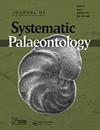对美国宾夕法尼亚州晚三叠世神秘的大头爬行动物宾夕法尼亚Sphodrosaurus Pennsylvania的骨骼学和系统发育关系的重新评估表明,它与始龙类有亲缘关系
IF 2.2
2区 地球科学
Q3 EVOLUTIONARY BIOLOGY
引用次数: 6
摘要
大多数三叠纪陆生底辟动物属于两个分支,鳞翅龙形目或(更多样的)古龙形目。然而,由于缺乏系统发育相关解剖区域的保存,或者由于特征的不寻常组合,一些三叠纪底辟的系统发育关系几十年来一直不确定。其中一种神秘的形态是宾夕法尼亚州纽瓦克超群上三叠统哈默溪组的小型宾夕法尼亚Sphodrosaurus pennylvanicus。它最初被确定为一种前钩龙类副爬行动物,后来被确定为可能的钩吻龙-原龙形,最近被确定为不确定的新底辟动物。在这里,我们修改了宾夕法尼亚Sphodrosaurus的解剖学,以便首次将其纳入定量系统发育分析中,该分析侧重于二叠纪-三叠纪新底辟动物。宾夕法尼亚Sphodrosaurus pennylvanicus在本次分析中被发现为Archosauromorpha中的一种doswellid proterochampisian。因此,该分类单元被添加到美国东部和西南部卡尼阶-诺里阶已知的Doswellids名录中。之前的作者认识到宾夕法尼亚狮身龙最不寻常的特征是其比例非常大的头骨。系统发育广义最小二乘回归证实,宾夕法尼亚狮身龙的头骨比绝大多数二叠纪-三叠纪底辟动物都大。头骨宽度与骶前长度之比的系统发育优化表明,最有可能的情况是宾夕法尼亚狮身人龙的头骨非常宽,是自变形的,但它在原始龙类中并不独特,与超适应盘龙和变形盘龙类似。对线性测量形态空间的探索表明,宾夕法尼亚Sphodrosaurus与可能是半水生的Proterochampsa barrionuevoi有着强烈的相似性,这表明前一物种可能有着相似的生活模式。对有蹄类功能类别的线性判别分析发现,宾夕法尼亚Sphodrosaurus pennylvanicus唯一保存的有蹄类适合挖掘或其他基质处理方式。本文章由计算机程序翻译,如有差异,请以英文原文为准。
A re-assessment of the osteology and phylogenetic relationships of the enigmatic, large-headed reptile Sphodrosaurus pennsylvanicus (Late Triassic, Pennsylvania, USA) indicates archosauriform affinities
Most Triassic terrestrial diapsids belong to two clades, Lepidosauromorpha or (the more diverse) Archosauromorpha. Nevertheless, the phylogenetic relationships of some Triassic diapsids have remained uncertain for decades because of the lack of preservation of phylogenetically relevant anatomical regions or because of unusual combinations of features. One of these enigmatic forms is the small-sized Sphodrosaurus pennsylvanicus from the Upper Triassic Hammer Creek Formation of the Newark Supergroup in Pennsylvania (USA). It was first identified as a procolophonid parareptile, later as a probable rhynchosaur archosauromorph, and more recently as an indeterminate neodiapsid. Here we revise the anatomy of Sphodrosaurus pennsylvanicus in order to include it for the first time in a quantitative phylogenetic analysis, which is focused on Permo–Triassic neodiapsids. Sphodrosaurus pennsylvanicus is recovered in this analysis as a doswelliid proterochampsian within Archosauromorpha. As a result, this taxon is added to the list of doswelliids known from the Carnian–Norian of the eastern and south-western USA. Previous authors recognized that the most unusual feature of Sphodrosaurus pennsylvanicus is its proportionally very large skull. Phylogenetic generalized least squares regressions confirmed that Sphodrosaurus pennsylvanicus has a larger skull than the vast majority of Permo–Triassic diapsids. Optimization in the phylogeny of the skull width to presacral length ratio shows the most likely scenario is that the extremely broad skull of Sphodrosaurus pennsylvanicus is autapomorphic, but it is not unique among archosauromorphs, being paralleled by hyperodapedontine rhynchosaurs and the proterochampsian Proterochampsa barrionuevoi. Exploration of a morphospace of linear measurements shows that Sphodrosaurus pennsylvanicus shares strong similarities with the probably semi-aquatic Proterochampsa barrionuevoi, suggesting that the former species may have had a similar mode of life. A linear discriminant analysis of ungual functional categories found that the only preserved ungual of Sphodrosaurus pennsylvanicus was suitable for digging or some other way of substrate processing.
求助全文
通过发布文献求助,成功后即可免费获取论文全文。
去求助
来源期刊
CiteScore
5.30
自引率
7.70%
发文量
31
审稿时长
>12 weeks
期刊介绍:
The Journal of Systematic Palaeontology publishes papers that provide novel and impactful results in phylogenetics and systematics and that use these results in ways that significantly advance rigorous analyses of palaeogeography, palaeobiology, functional morphology, palaeoecology or biostratigraphy. Papers dealing with theoretical issues or molecular phylogenetics are also considered if they are of relevance to palaeo-systematists. Contributions that include substantial anatomical descriptions, descriptions of new taxa or taxonomic revisions are welcome, but must also include a substantial systematics component, such as a new phylogeny or a revised higher-level classification. Papers dealing primarily with alpha-taxonomic descriptions, the presentation of new faunal/floristic records or minor revisions to species- or genus-level classifications do not fall within the remit of the journal.

 求助内容:
求助内容: 应助结果提醒方式:
应助结果提醒方式:


